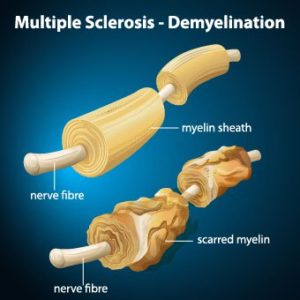Understanding Multiple Sclerosis
 Multiple Sclerosis: When Your Body’s Protection System Gets Confused
Multiple Sclerosis: When Your Body’s Protection System Gets Confused
Imagine your nerves as electric wires in your body.
Just like wires have a protective coating, your nerves have something similar called the myelin sheath.
In Multiple Sclerosis (MS), this protective coating is attacked by the immune system—it’s like the body’s defense team gets confused and attacks the wrong target.
MS is a bit mysterious, like a puzzle that doctors and scientists are still trying to solve.
While we don’t know exactly what causes it, we have some strong clues that viruses and family genes play a role.
Interestingly, MS tends to show up more often in women than men, usually when people are between 40 and 60 years old.
Here’s what makes MS tricky to spot: it’s like a chameleon, changing its appearance from person to person.
Some days, you might feel perfectly fine; other days, symptoms pop up out of nowhere.
This on-again, off-again pattern, especially in the early stages, can make it take years before doctors can say, “Yes, this is definitely MS.”
There are four different ways MS can behave in your body.
First, there’s what doctors call Clinically Isolated Syndrome (CIS).
Think of it as a warning sign – a single episode where something feels off in your body.
When doctors look at brain scans (MRIs), some people show spots (called lesions) that suggest MS might develop, while others don’t show these spots and might never get MS.
Then there’s Relapsing. RemiRelapsing-Remittingcture is like a roller coaster—you have periods where symptoms flare up (attacks), followed by times when they calm down (remission).
Some people find their symptoms worsening, while others stay fairly stable between attacks.
Most people with RRMS eventually move into Secondary Progressive MS (SPMS).
This is like climbing stairs – there’s a steady increase in disability over time.
Lastly, there’s Primary Progressive MS, which is like sliding down a slope from the beginning.
The symptoms worsen over time, with maybe a few brief pauses along the way.
If you’re wondering what MS feels like, here are the main symptoms to watch for.ly or off-balance, like walking on a boat.
Muscles feel weak like you’ve just finished a long workout.
Vision getting blurry or even temporarily disappearing.
Parts of your body feel numb, like when your foot falls asleep.
A weird electric shock feeling when you bend your neck.
Have trouble with your bladder or bowels?
Feeling sick? to your stomach or throwing up.
Remember, these symptoms can come and go, and not everyone experiences all of them.
It’s like each person with MS writes their own unique story.
See more about the symptoms and diagnosis of MS.
Treatments for MS
Conventional treatments include steroids and immunosuppressants.
The problem with immunosuppressants is that they suppress your immune system, making you susceptible to infection and cancer.
Steroids weaken bones, tendons, and ligaments and also cause weight gain.
Alternative treatments can be very successful without the harmful side effects.
Following an anti-inflammatory diet can affect one’s quality of life and reduce relapses while slowing down the progression of the disease.
Medical cannabis is a cannabis are-inflammatory and natural pain remedy.
Stem cell therapy is becoming more well-known, and we are getting rapid results from this non-invasive therapy.
Stem cell therapy is a powerful immuno-modulating treatment and is also anti-microbial.
All of these treatments are available in our office.
Contact us to schedule your appointment.
